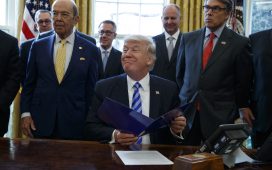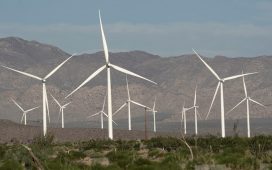Efforts to mitigate climate change are creating investment opportunities in agriculture, utilities and artificial intelligence.
Getty
According to CDP, an international nonprofit, approximately 200 of the world’s largest companies collectively peg their climate change exposure at nearly $1 trillion. Manufacturers around the globe cite changing weather patterns and rising seas and rivers as increasingly disruptive to their supply chain. Within the U.S. utility industry, executives name climate change as one reason behind increasingly fierce wildfires, which have destroyed transmission and distribution infrastructure. While all of this may portend darkening financial skies, some see a different forecast developing. One where there are not only ideas but also action and financial opportunities. Some experts even see tailwinds for investors.
Action At The State Level
“Out of Washington, D.C., you hear rhetoric of inaction with regard to addressing climate change, but there is in fact traction,” says Ryan A. McPherson, chief sustainability officer for the State University of New York at Buffalo. “The recurring theme I see is action taken at the state level.”
For example, as far back as 2007, California helped establish The Climate Registry to help manage the reporting of emissions by corporations, universities and state and local governments. In 2009, several Northeastern states cooperated in launching The Regional Greenhouse Gas Initiative, or RGGI, a regional cap-and-trade program for carbon dioxide emissions from power plants.
“The North American carbon futures, if you include RGGI, has generated a combined open interest of more than 700,000 contracts; compare that to 564,000 contracts for gold,” remarks Richard Sandor, founder of the Chicago Climate Exchange, which helps reduce and trade greenhouse gases. “It’s under everyone’s radar.”
McPherson notes the work going on in approximately two dozen states to achieve commitments outlined in the Paris Agreement, including New York Governor Andrew Cuomo recently signing the Climate Leadership and Community Protection Act that mandates the Empire State go entirely carbon-neutral by 2050. Getting there will require the construction of, among other things, wind farms. One utility industry executive spoken with for this column says projects like the ones envisioned by New York and other utility companies around the country, which include burying transmission lines to protect them from wild fires, will mean an uptick in construction jobs. Those are jobs, say experts, that companies will fill with union and non-union workers; it also means economic growth for communities and more business for the firms that design and build transmission and distribution projects.
“Because of the public debate, people think nothing’s getting done on climate change,” adds McPherson. “If you’re a PE-backed company or looking for PE, the race is on; the giants are putting down a footprint.”
For example, some of the major airlines and aircraft makers are investing in electric motors to augment combustion engines. It’s an investment strategy that’s riding the wave of electrically powered ground vehicles where automakers and their suppliers are playing. A handful of U.S. electric utilities are exploring or making investments in fuel cells and microgrids to provide low- or no-carbon energy solutions.
“Money Will Flow”
Bob Inglis, a former U.S. Congressman and now executive director of republicEn, a conservative nonprofit, advocates for free enterprise solutions to climate change. “I care about people’s jobs, but I’m not interested in protecting ‘buggy-whip industries,’” says Inglis. “Innovation and investment will create new jobs.”
According to Inglis, the world of private equity will move rapidly to invest in energy innovation when the U.S. begins pricing carbon dioxide. When that’s finally done, says Inglis, the economics will help all kinds of projects become profitable. He argues for a carbon tax, which is revenue neutral and border adjustable. Anything that’s domestic only puts America in a lose-lose situation, says Inglis. In that scenario, people who have energy-intensive operations will move operations to Asia and emit even more carbon dioxide equivalent. The tax, according to Inglis, must be worldwide.
“We know everyone wants access to U.S. markets,” says Inglis. “But to get access, you’re going to pay our carbon tax if you don’t have one at home; carbon emission anywhere is climate change everywhere.”
To hear experts like Inglis talk about it, once billions of people see the true cost of energy, corporations and consumers will look for ways to save money and find energy efficient alternatives to all manner of goods and services. For now, experts say, the economics still reward companies that pollute. They argue there’s a kind of implicit subsidy for manufacturers belching carbon dioxide equivalents into the air, without paying the healthcare and climate costs associated with it.
“We think conservatives will realize that this is rock-solid conservatism; all it takes is fixing the economics,” says Inglis. “Money will flow to innovators, and investing is an essential part of solving climate change.
“I hope we’re not just addressing climate change from a position of fear,” adds Inglis. “I hope, as a nation, we also recognize the incredible ways advocating for climate change can spur economic innovation, growth and advance human vitality.”
In the meantime, the rise of projects linked to mitigating climate change – such as restoring wetlands, raising roads, removing carbon from agricultural soil, designing and developing more energy-efficient, powerful pumps, reducing meat consumption, or constructing new transmission lines and tunnels – may be a tailwind for investors looking to put capital to work.
“There are opportunities in agriculture, utilities, artificial intelligence,” adds Sandor. “For people who are developing PE, there’s an enormous opportunity and amount of things to be long; and, with publicly traded companies, many opportunities to be short.”







